UNIT 7: The Skeletal System
0.0(0)
Card Sorting
1/120
Study Analytics
Name | Mastery | Learn | Test | Matching | Spaced |
|---|
No study sessions yet.
121 Terms
1
New cards
how many bones are in an adult human?
206
2
New cards
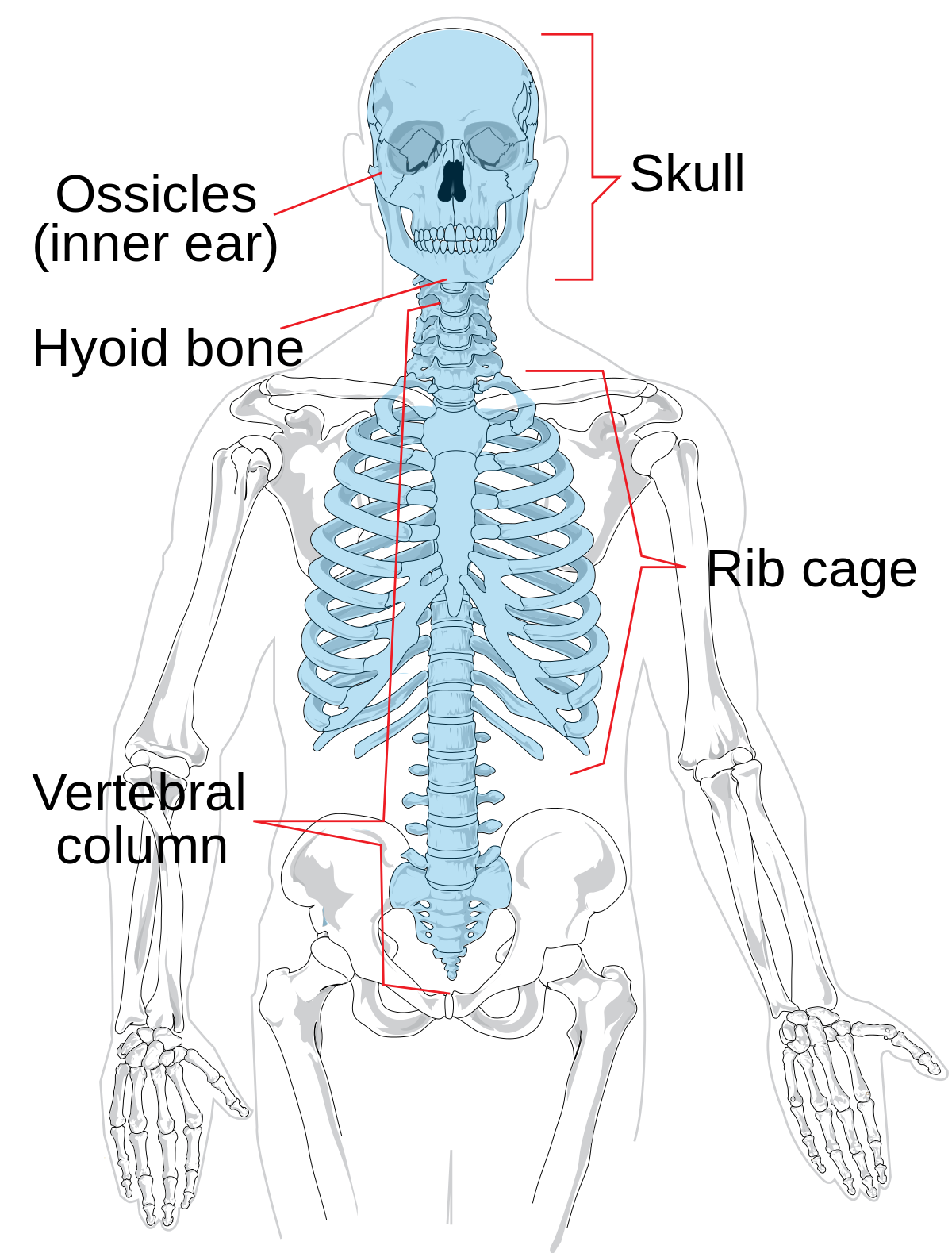
what makes up the axial skeleton?
bones of…
* skull
* Hyoid
* vertebral column
* thorax
* skull
* Hyoid
* vertebral column
* thorax
3
New cards
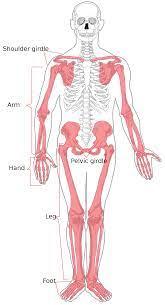
what makes up the appendicular skeleton?
bones of…
* upper & lower limbs
* pectoral & pelvic girdles
* upper & lower limbs
* pectoral & pelvic girdles
4
New cards
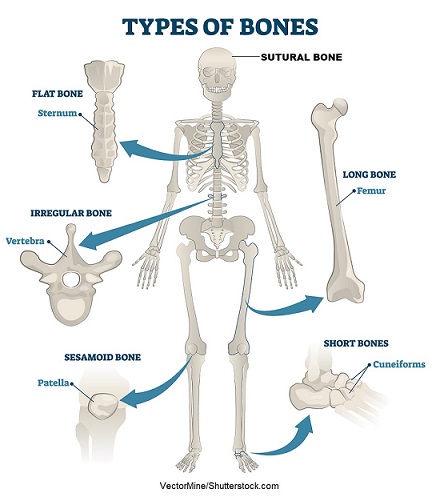
long bones
long longitudinal axes & expanded ends
* e.g. forearm, femur
* e.g. forearm, femur
5
New cards
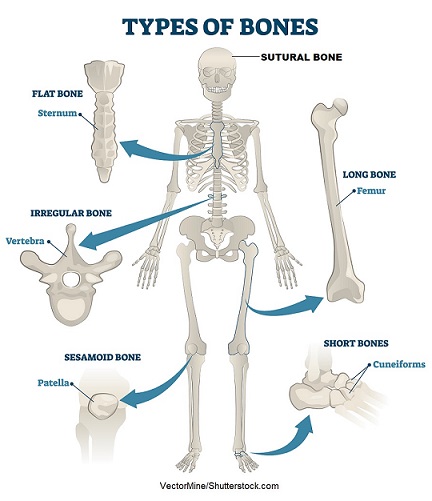
short bones
lengths and widths the same
* wrists, ankles
* sesamoid/round bones
* wrists, ankles
* sesamoid/round bones
6
New cards
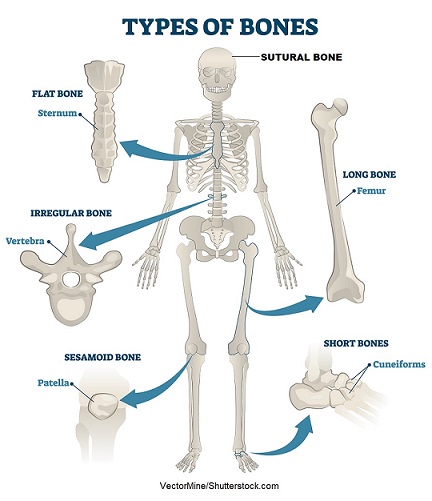
sesamoid/round bones
small, nodular, develops within tendon or adjacent to joint
* e.g. patella
* e.g. patella
7
New cards
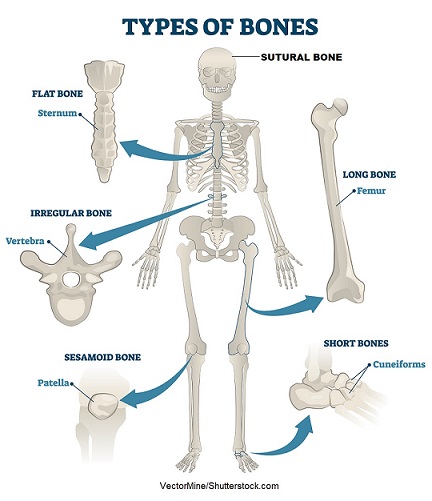
flat bones
platelike, broad surfaces
* e.g. ribs, scapulae, some skull
* e.g. ribs, scapulae, some skull
8
New cards
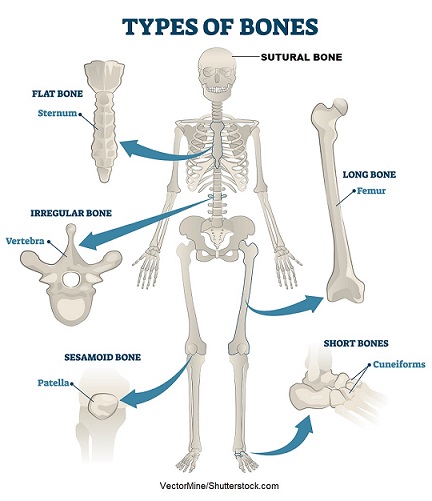
irregular bone
variety shapes, most connected to other bones
* vertebrae, some face bones
* vertebrae, some face bones
9
New cards
think back to the relationship between the anatomy of body parts and their functions.
\
complete the statement:
\
"bone’s _____ makes possible its ________.”
\
complete the statement:
\
"bone’s _____ makes possible its ________.”
bone’s __shape__ makes possible its __function.__
10
New cards
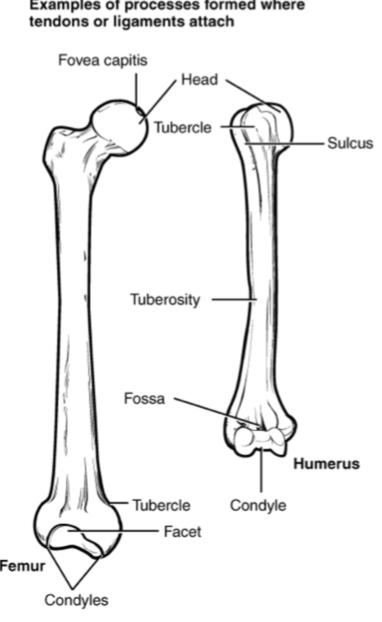
elevations or bone projections (processes) are useful for what?
tendon & ligament attachment
11
New cards
depressions, grooves, & tunnels are useful for what?
blood vessels or nerve passages
12
New cards
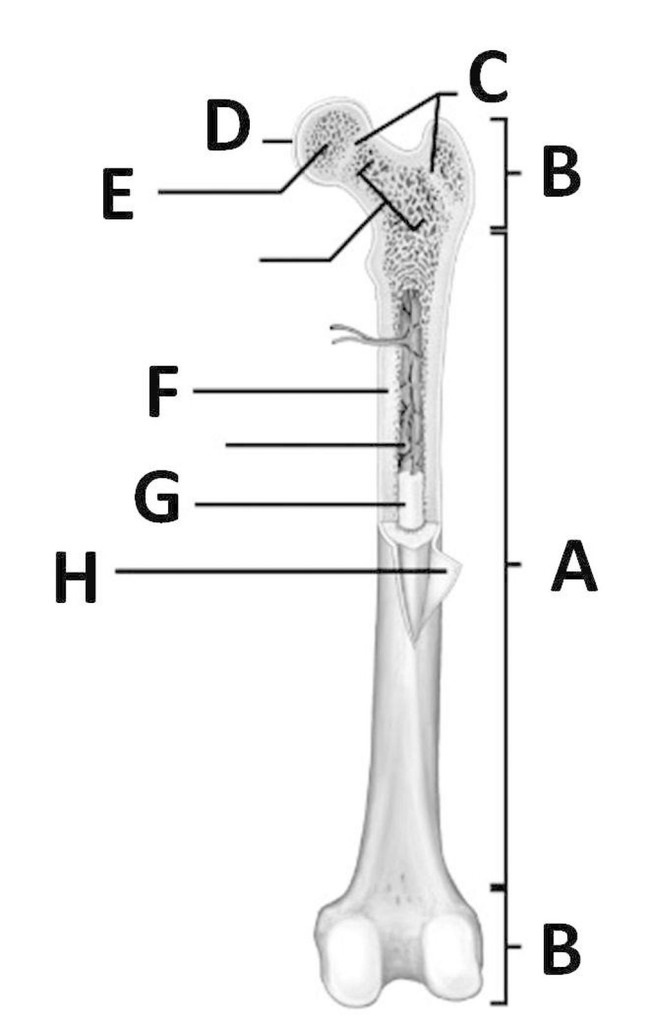
A
diaphysis
* shaft of long bone, between epiphysis
* shaft of long bone, between epiphysis
13
New cards

B
top B = proximal epiphysis
* nearest attachment to trunk of body
lower B = distal epiphysis
* farthest attachment to trunk of body
* nearest attachment to trunk of body
lower B = distal epiphysis
* farthest attachment to trunk of body
14
New cards
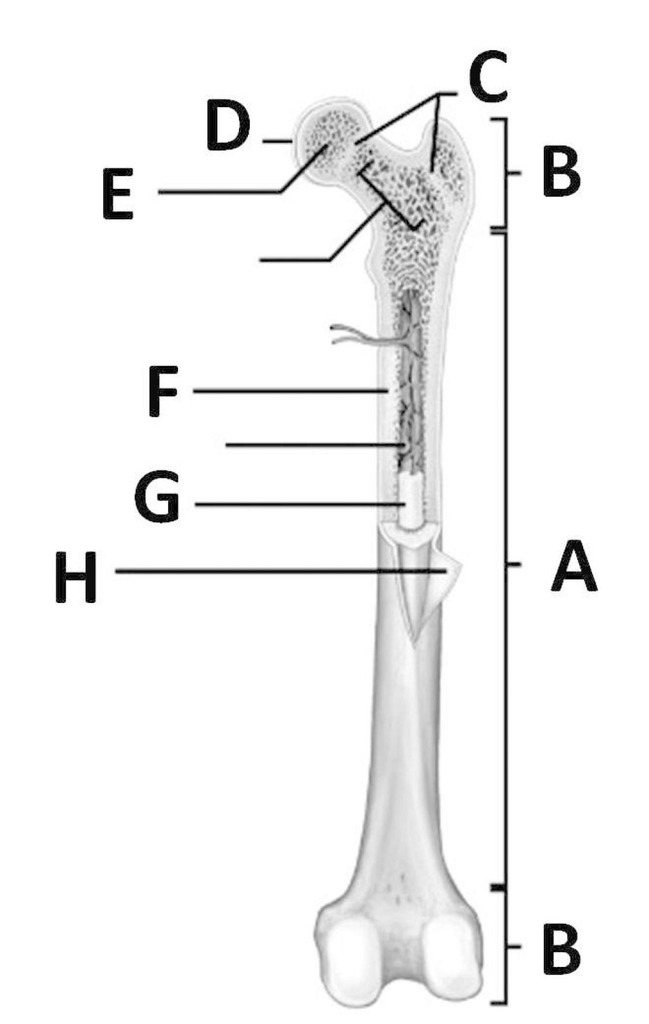
C
epiphyseal lines
* region where epiphysis & diaphysis fuse together during growth
* region where epiphysis & diaphysis fuse together during growth
15
New cards
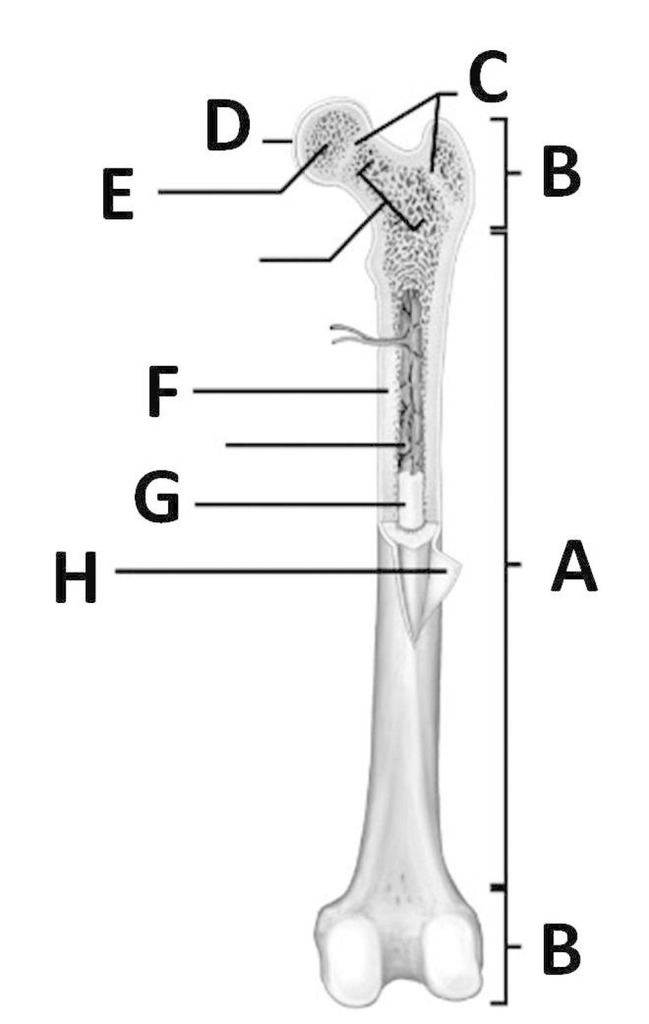
D
articular cartilage
* outer surface of articulating portion of epiphysis coated in layer of hyaline cartilage
* outer surface of articulating portion of epiphysis coated in layer of hyaline cartilage
16
New cards
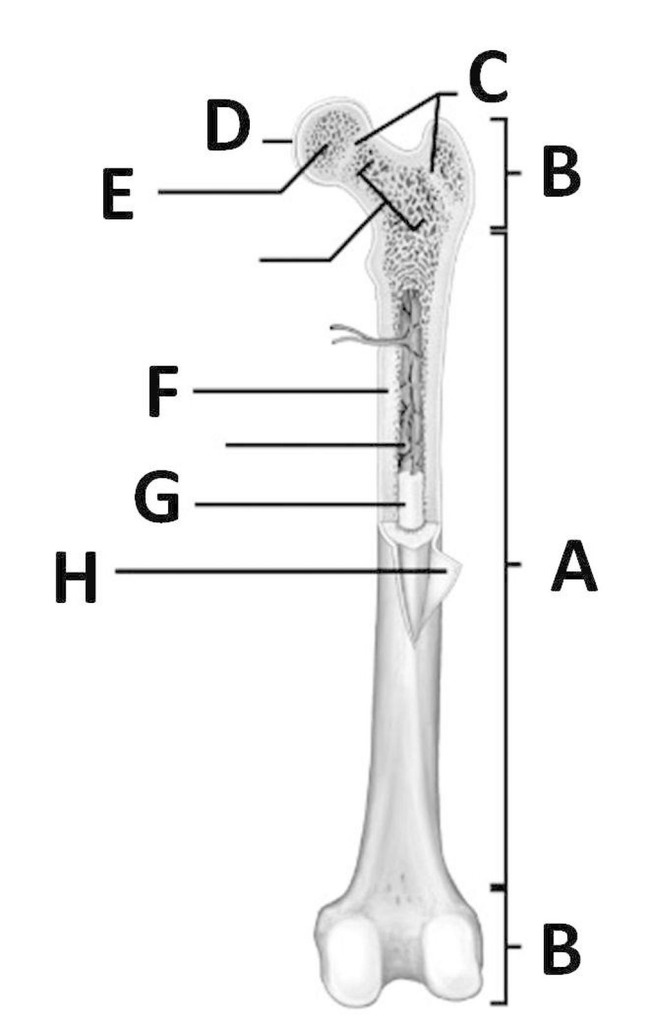
E
spongy bone
17
New cards
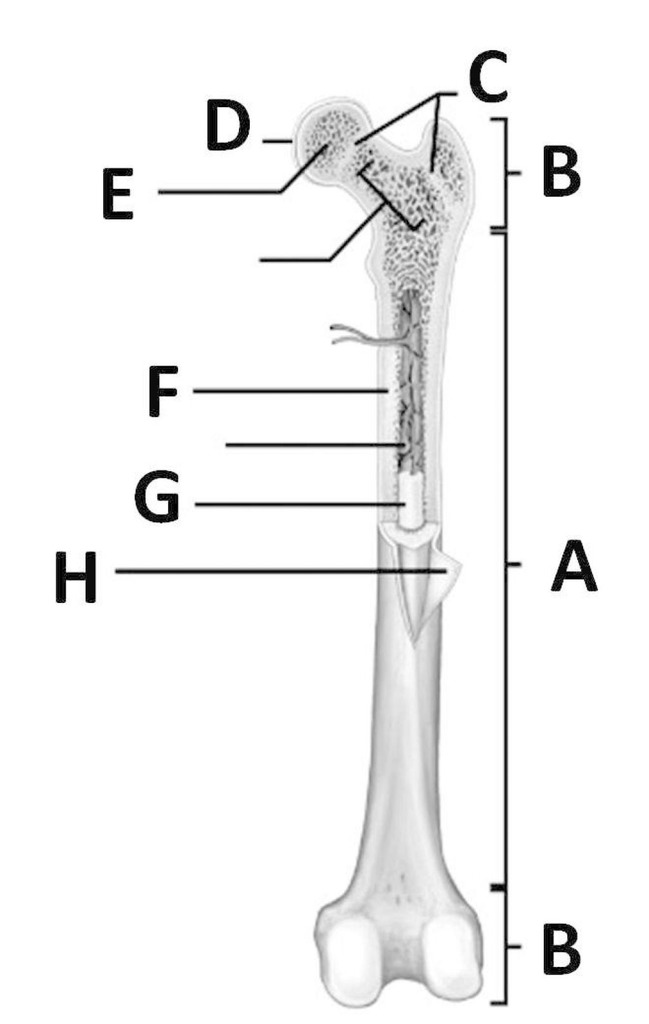
bracket below E
spaces containing red marrow
18
New cards
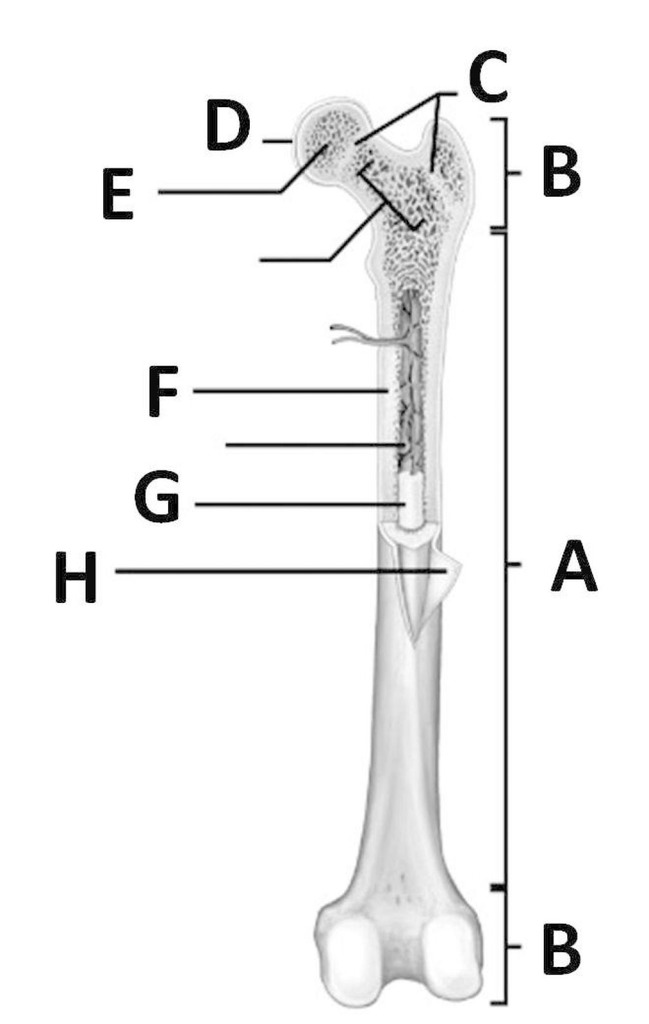
F
compact bone
19
New cards
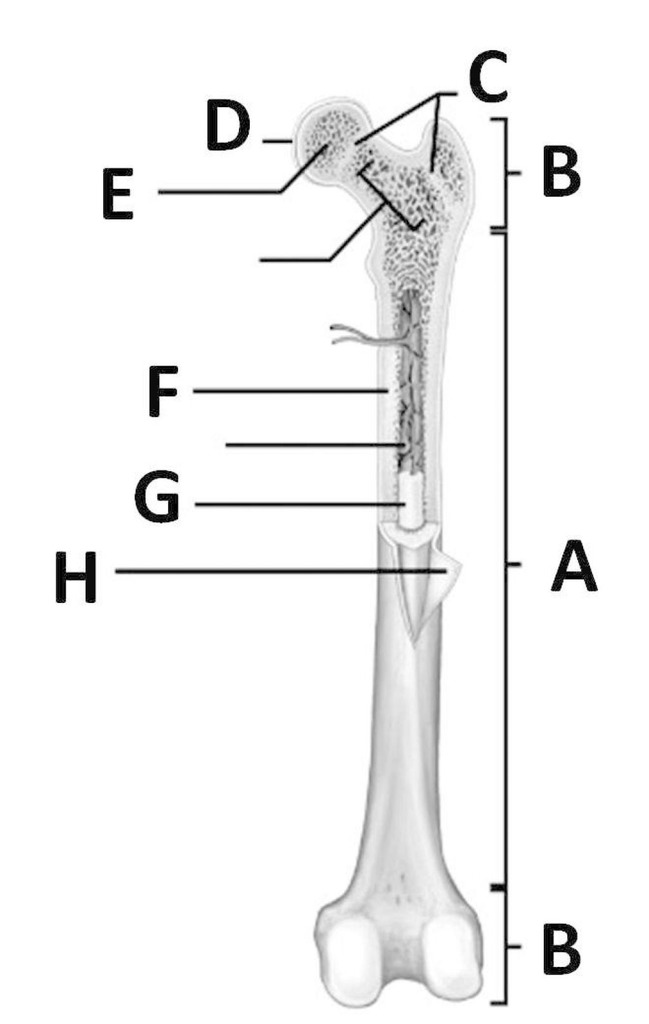
line below F
medullary cavity
* cavity containing red or yellow marrow within diaphysis of long bone
* cavity containing red or yellow marrow within diaphysis of long bone
20
New cards
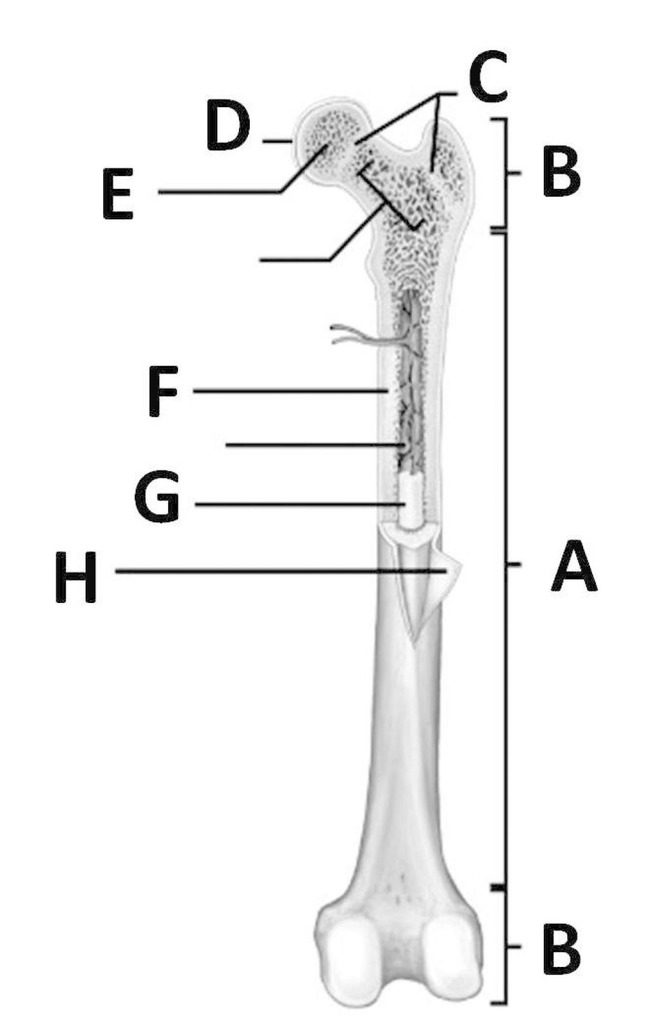
G
yellow marrow
21
New cards
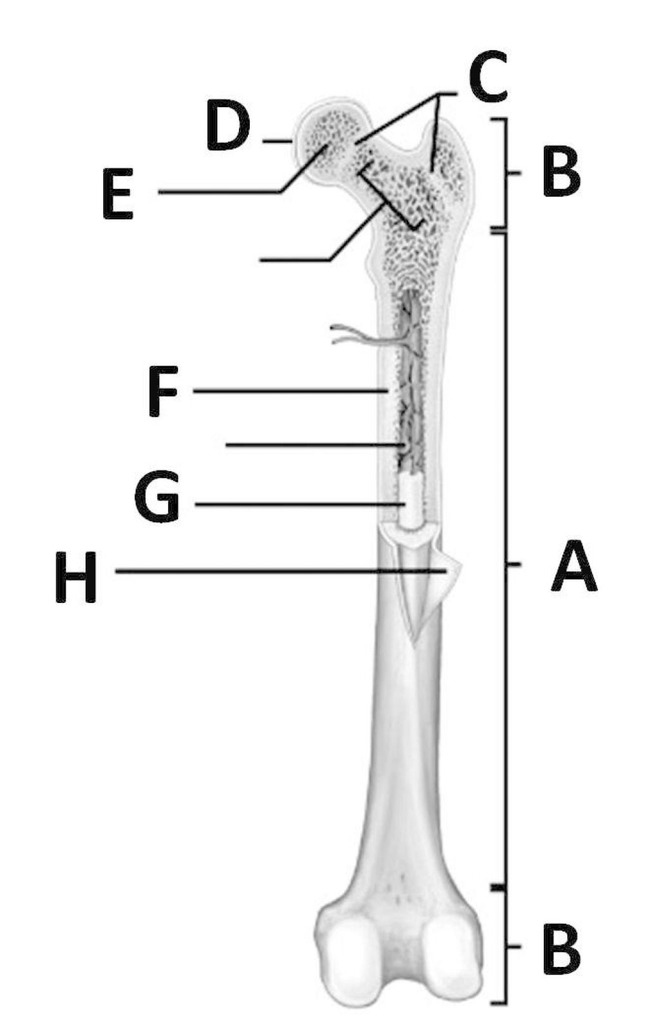
H
periosteum
* dense connective tissue covering bone surface
* dense connective tissue covering bone surface
22
New cards
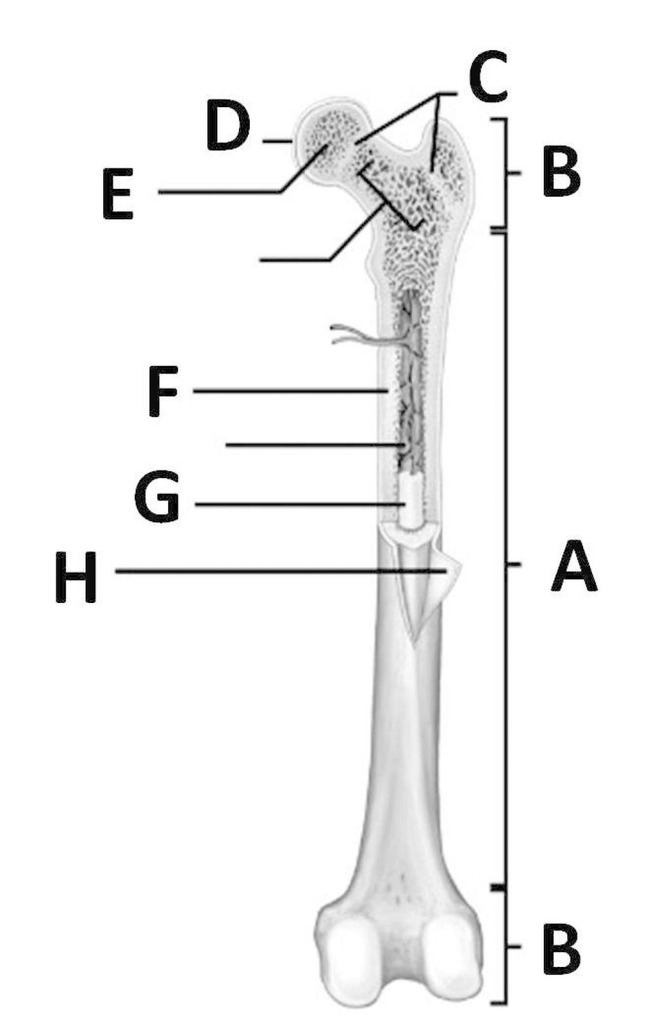
point to the endosteum
tissue lining medullary cavity
23
New cards
where can marrow be found
1. medullary cavities of long bones
2. irregular spaces of spongy bone
3. larger central canals of compact tissue
24
New cards
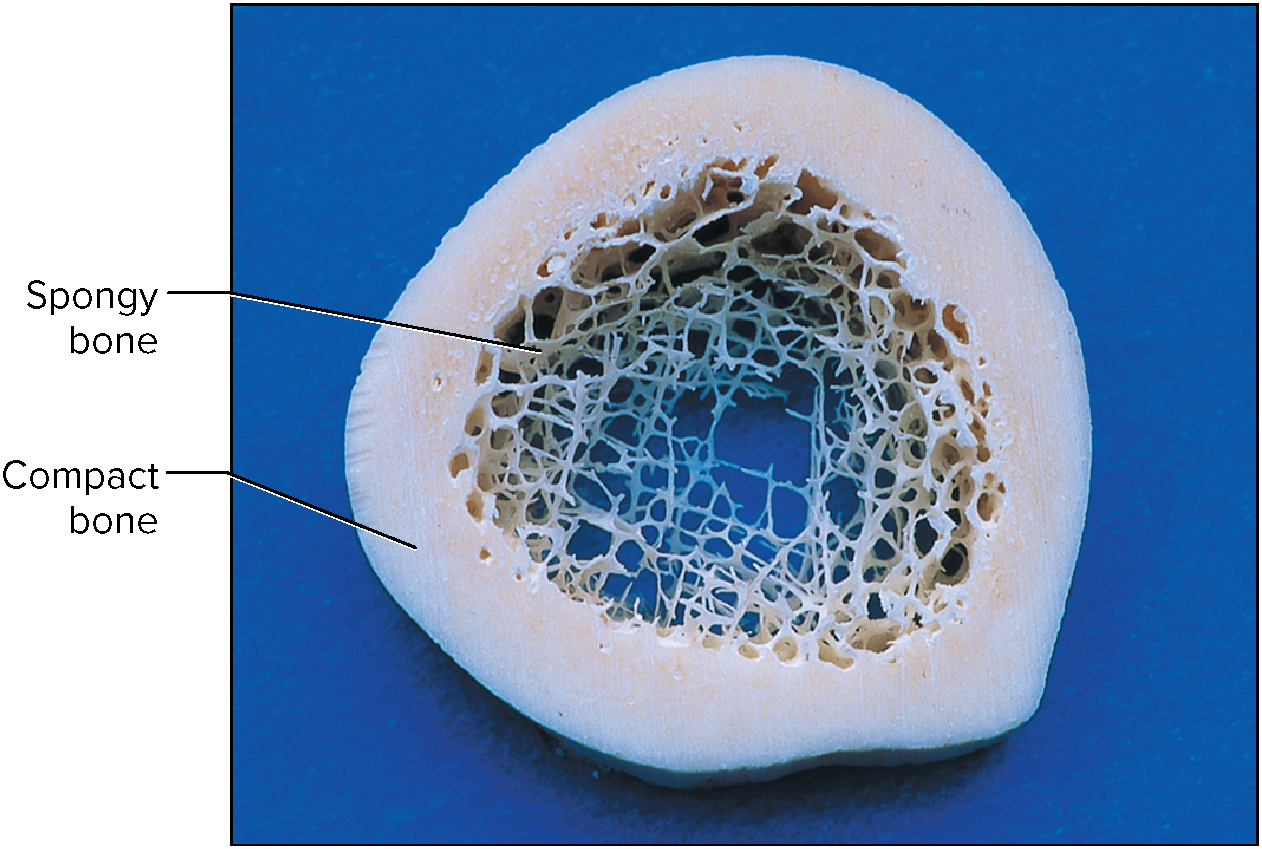
compact bone (cortical bone)
**what?** dense bone tissue in which cells are organized in osteons without apparent spaces
**where?** wall of diaphysis
**where?** wall of diaphysis
25
New cards
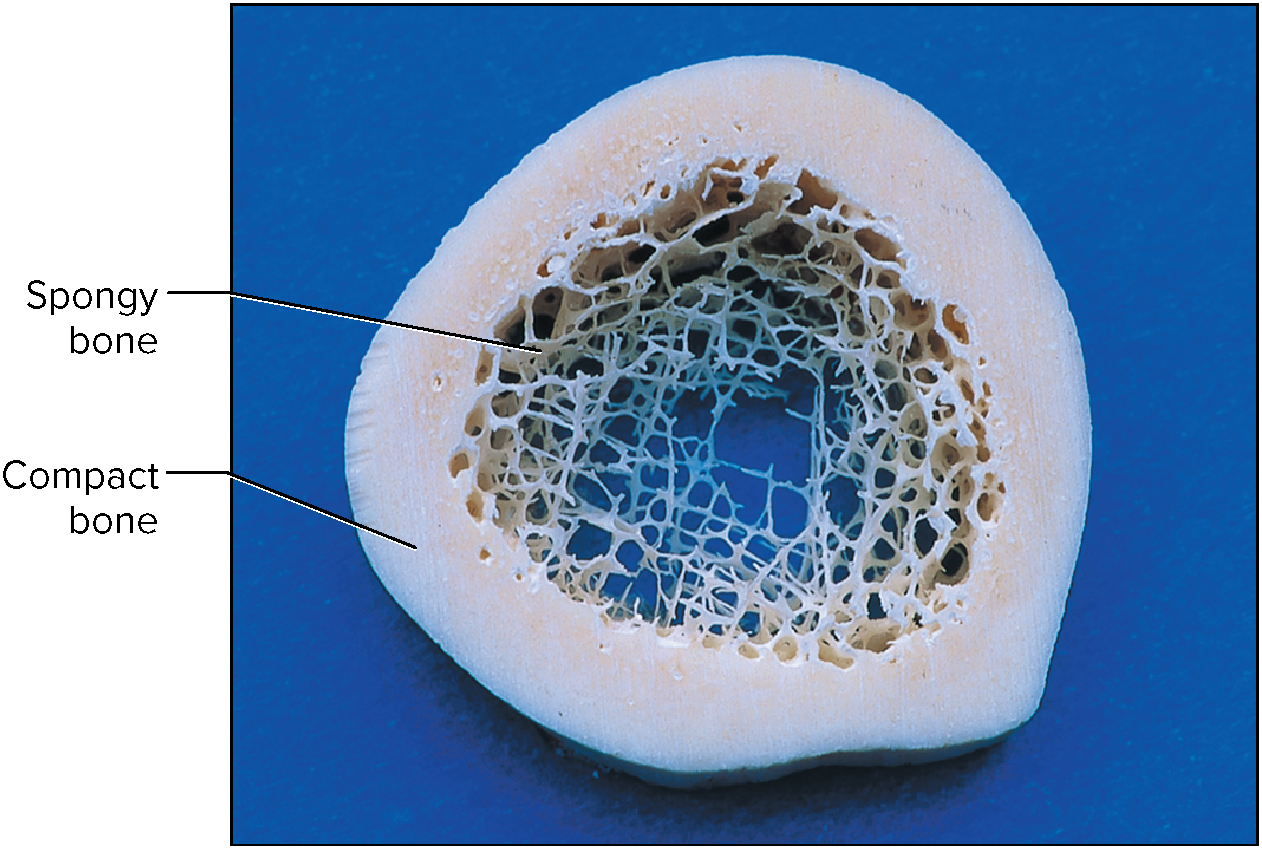
spongy bone (cancellous bone)
**what?** bone that consists of bars & plates separated by irregular spaces
* trabeculae
**where?** epiphysis
* trabeculae
**where?** epiphysis
26
New cards
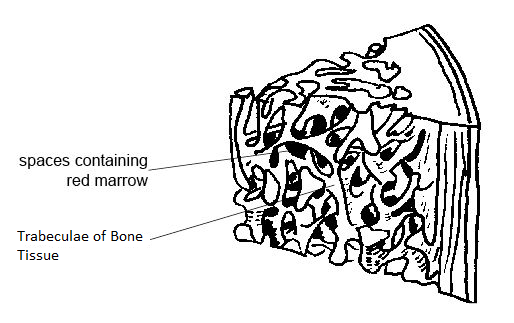
trabeculae
branching bony plate that separates irregular spaces within spongy bone
27
New cards
why is trabeculae important?
help reduce weight of bone
28
New cards
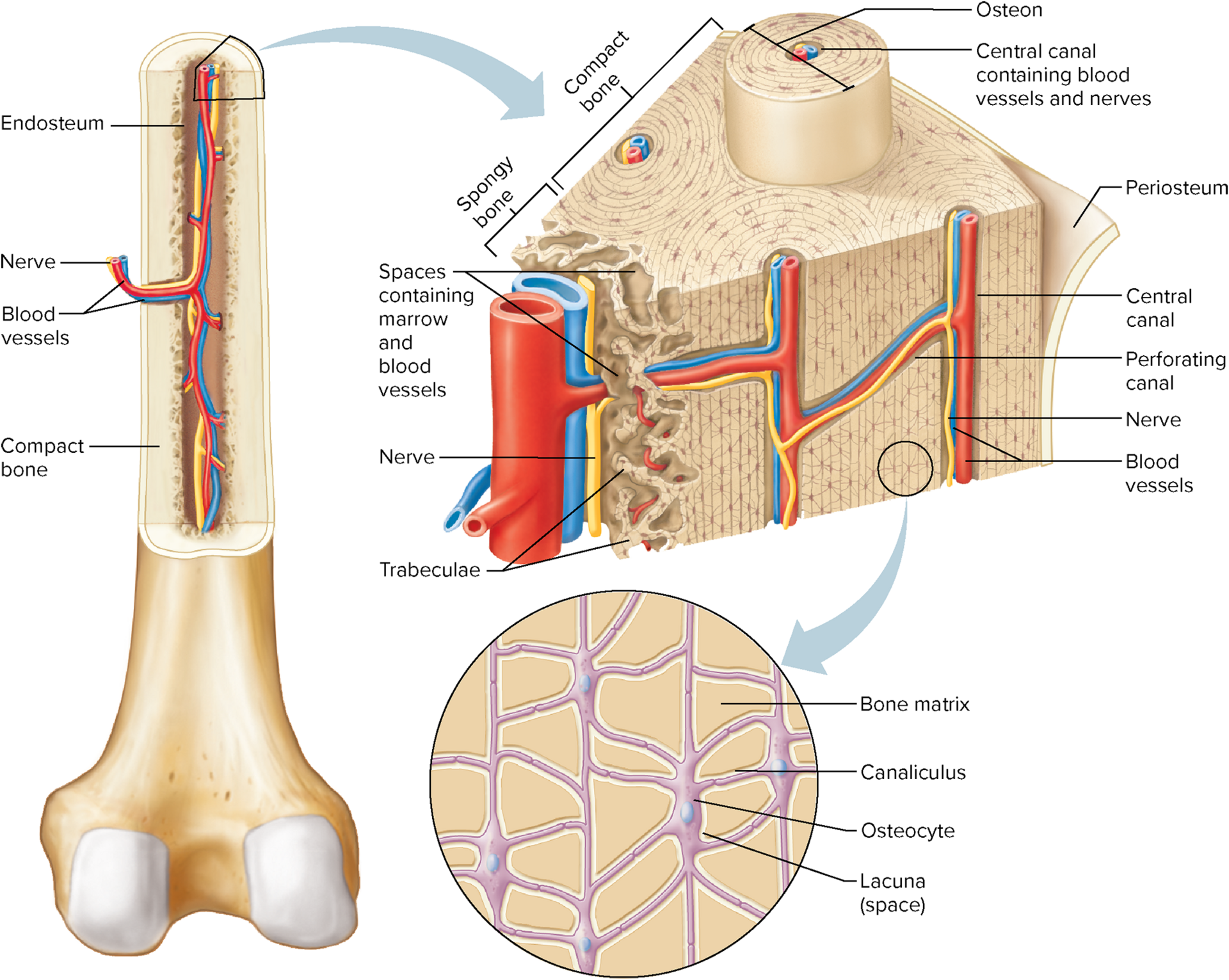
describe the microscopic structure of compact bone
1. compact bone consists of densely packed, cylinders called *osteons*. each osteon contains osteocytes & extracellular matrix deposited in rings (*lamellae*) around a central canal.
2. blood vessels & nerves occupy the central canal & provide a blood supply & neural control to the bone tissue.
3. central canals extend longitudinally through bone tissue & transverse perforating canals (Volkmann’s canals) connect them.
4. osteocytes lie within tiny chambers called lacunae; they communicate & share nutrients with other osteocytes through canaliculi, tiny passages through which their extensions (processes) pass.
29
New cards

describe the microscopic structure of spongy bone
1. composed of osteocytes and extracellular matrix, but cells do not aggregate around central canals
2. rather, cells lie in trabeculae & get nutrients from substances diffusing into canaliculi that lead to surface of these thin, bony plates
30
New cards

bone functions
1. support, protection, movement
2. blood cell production (hematopoiesis)
3. lipid storage
4. storage of inorganic salts & minerals
31
New cards

support
supports WEIGHT
32
New cards
protect
body parts & internal organs
33
New cards
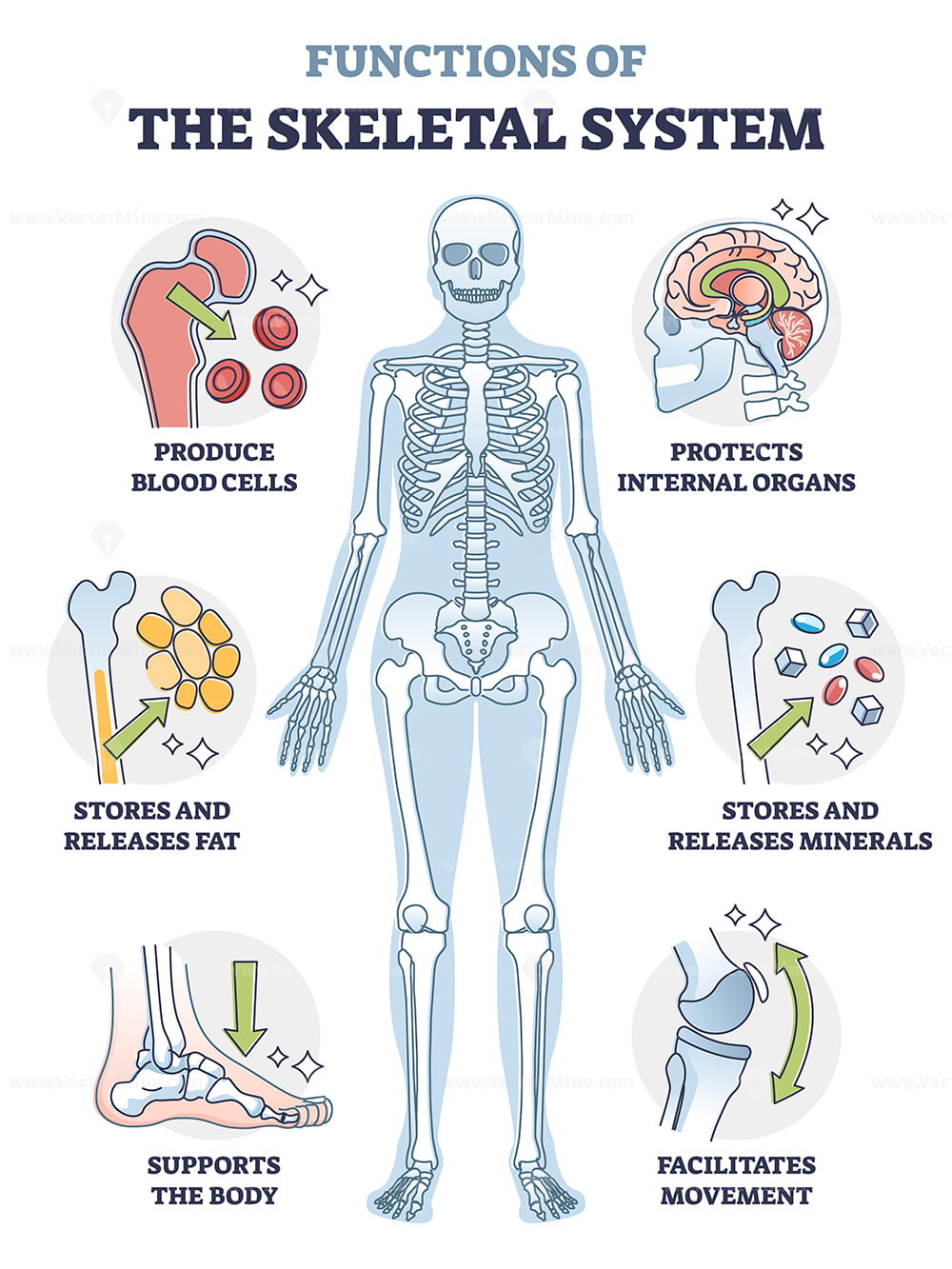
movement
light enough to work with muscles → leverage
34
New cards
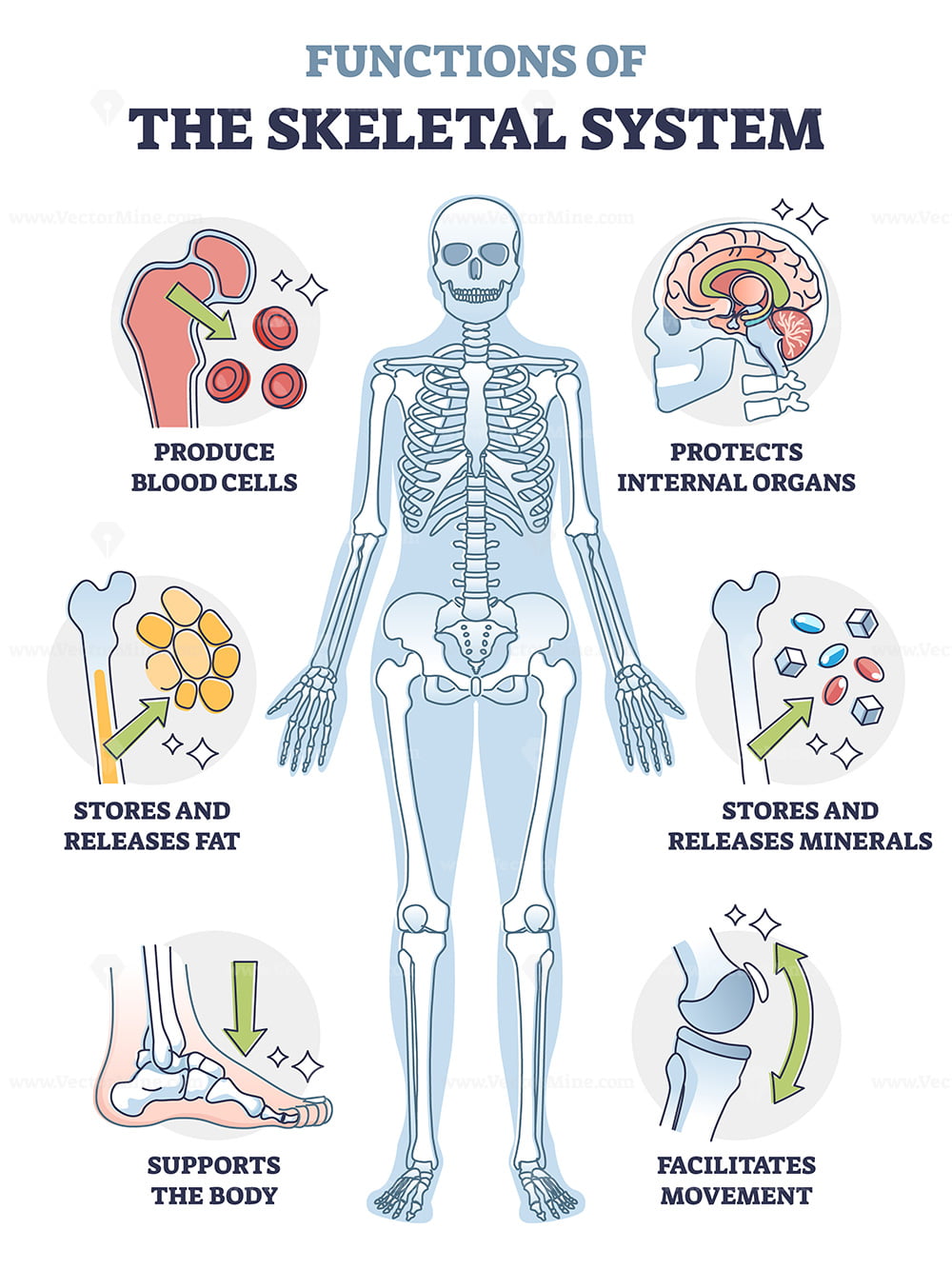
blood cell production (hematopoiesis)
red marrow: functions in formation of red blood cells (erythrocytes), white blood cells (leukocytes), & blood platelets
35
New cards
where is red marrow found
spongy bone of skull, ribs, sternum, clavicles, vertebrae, & hip bones
36
New cards
why is red marrow red?
hemoglobin (oxygen-carrying pigment in red blood cells)
37
New cards
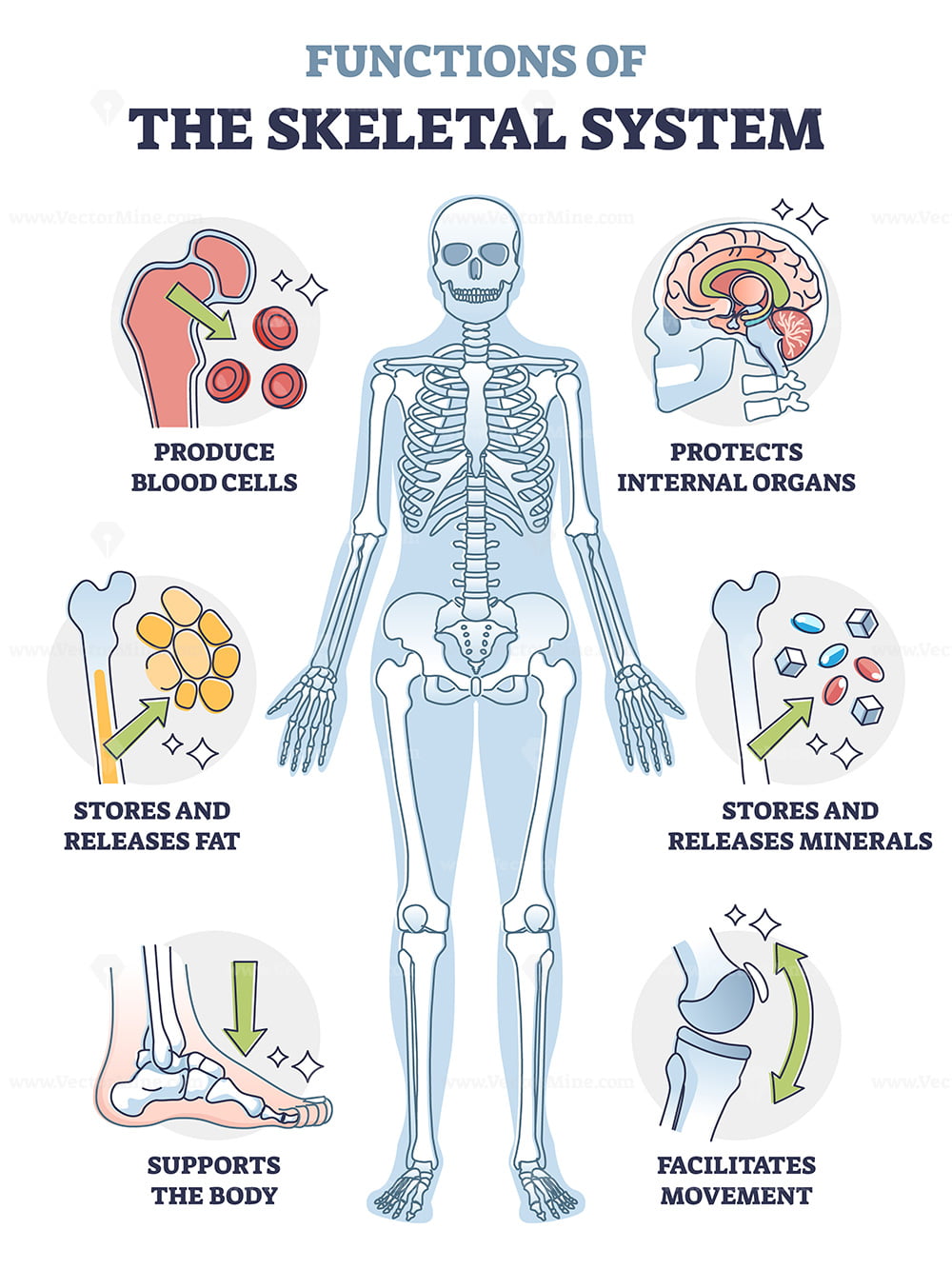
lipid storage
yellow marrow: fat storage in medullary cavities of certain bones
38
New cards
what is the relationship between red and yellow marrow?
* yellow marrow replaces much of red marrow into adulthood
* yellow marrow temporarily turns into red marrow if supply of blood cells is deficient
* yellow marrow temporarily turns into red marrow if supply of blood cells is deficient
39
New cards
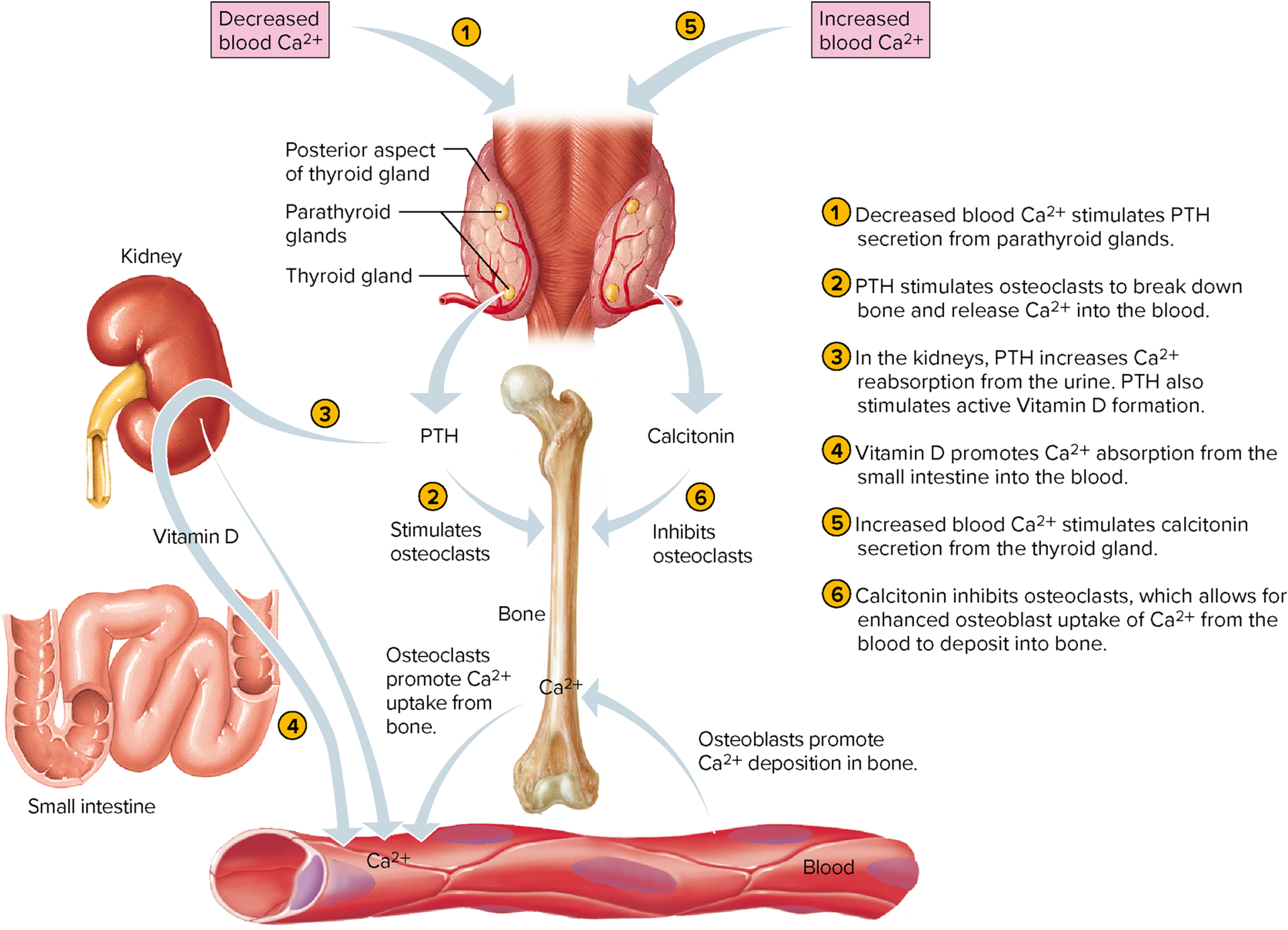
storage of inorganic salts & minerals
store calcium phosphate
* releasing calcium when low blood calcium level **(Parathyroid hormone)** & storing calcium when high blood calcium level
* releasing calcium when low blood calcium level **(Parathyroid hormone)** & storing calcium when high blood calcium level
40
New cards
why is maintaining sufficient blood calcium levels important
* muscle contraction
* nerve cell contraction
* blood clotting
* nerve cell contraction
* blood clotting
41
New cards
ossification
formation of bone
* begins in embryo & continues into adulthood
* begins in embryo & continues into adulthood
42
New cards
bones composed of:
1. collagen fibers
2. calcified matrix (calcium phosphate)
43
New cards
collagen fibers
* 1/3 of bone weight
* strong & flexible
* bends if compressed
* strong & flexible
* bends if compressed
44
New cards
calcified matrix (calcium phosphate)
* 2/3 of bone weight
* found in crystals
* hard, inflexible, brittle
* found in crystals
* hard, inflexible, brittle
45
New cards
why is a combo of collagen & calcified matrix benefit bones
make bone strong, somewhat flexible, & highly resistant to shattering
46
New cards
bone growth
1. interstitial growth
2. appositional growth
47
New cards
interstitial growth
* grows in length
* occurs at epiphyseal plate
* happens within bone
* occurs at epiphyseal plate
* happens within bone
48
New cards
appositional growth
* growth in diameter & thickness
* bone gets wider
* happens on bone’s outer surface
* \
* bone gets wider
* happens on bone’s outer surface
* \
49
New cards
intramembranous bones
originate between sheetlike layers of connective tissue
* CT vascular
* major skull bones
* CT vascular
* major skull bones
50
New cards
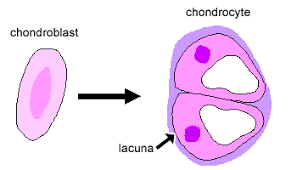
cartilage cells
chondrocytes: mature cell, live in lacunae
chondroblasts: young, active cells that produce matrix
chondroblasts: young, active cells that produce matrix
51
New cards
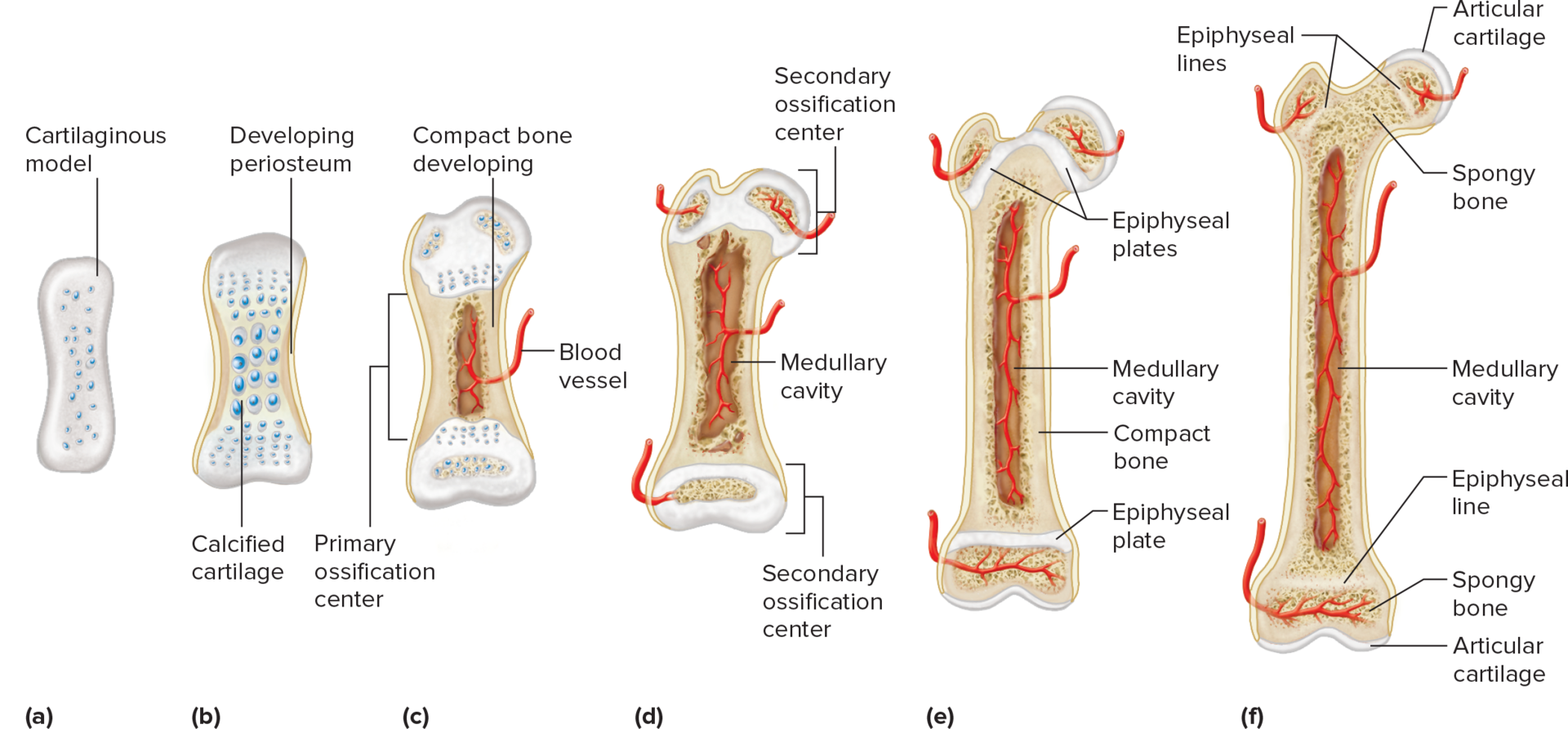
endochondral bones
bones that begin as hyaline cartilage that is subsequently replaced by bone tissue
52
New cards
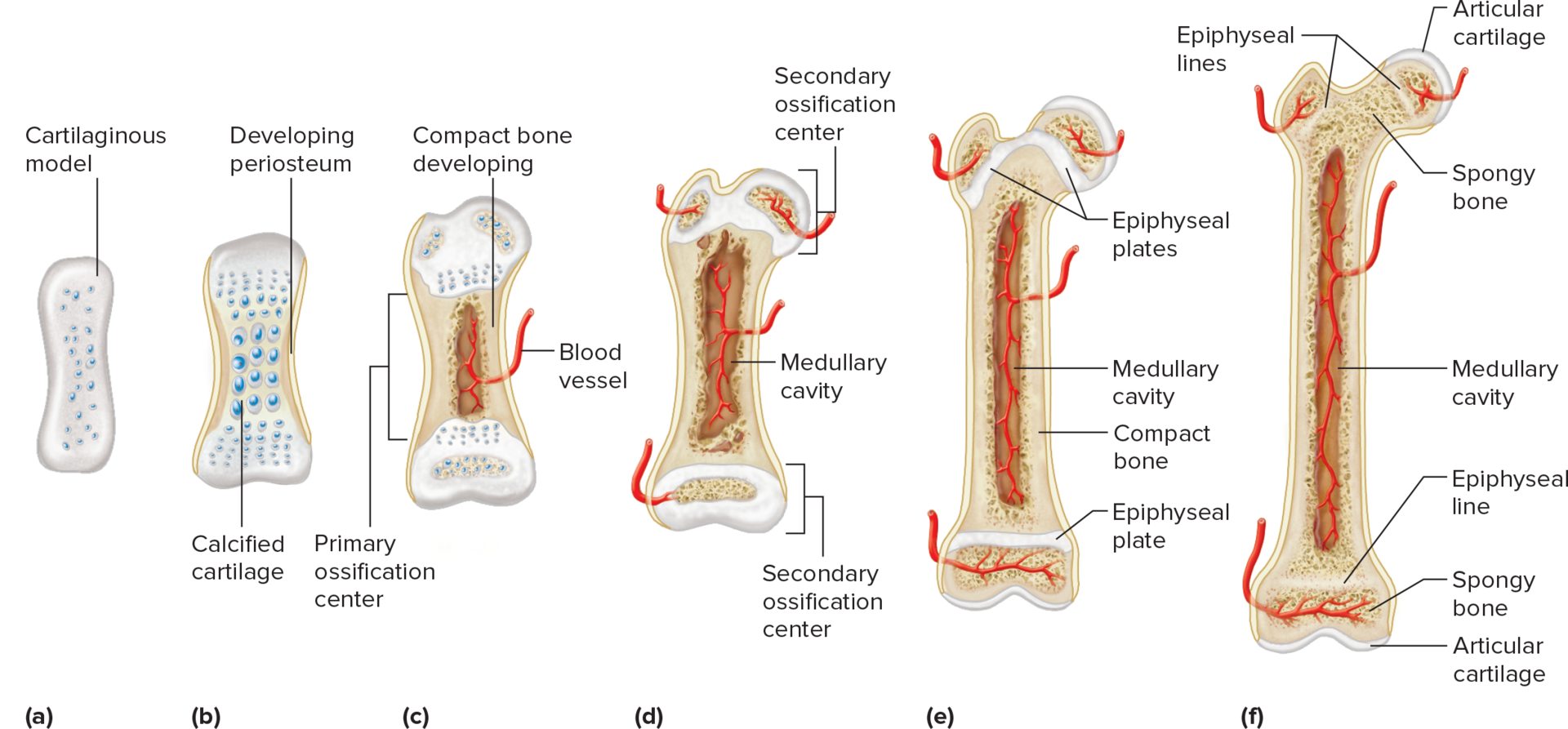
describe the development of endochondral bones
1. start w hyaline cartilage model. cartilage breakdown in middle of future diaphysis
2. bone collar develops to form periosteum, which surrounds future diaphysis
3. primary ossification center forms as osteoblasts & blood vessels from periosteum invade area of decomposing cartilage; here spongy bone tissue is deposited, & later a layer of compact bone is deposited over spongy bone; medullary/marrow cavity starts remodeling
4. secondary ossification centers form at the epiphysis, where spongy bone is produced; medullary/marrow cavity continues remodeling
5. image shows developed bone; interstitial growth occurs at epiphyseal plates between primary & secondary ossification centers
6. adult bone is represented by joined primary & secondary ossification centers, separated by epiphyseal lines (what remains after epiphyseal plate growth & closure)
53
New cards
epiphyseal plate
cartilaginous later between epiphyses & diaphysis of a long bone that grows
54
New cards
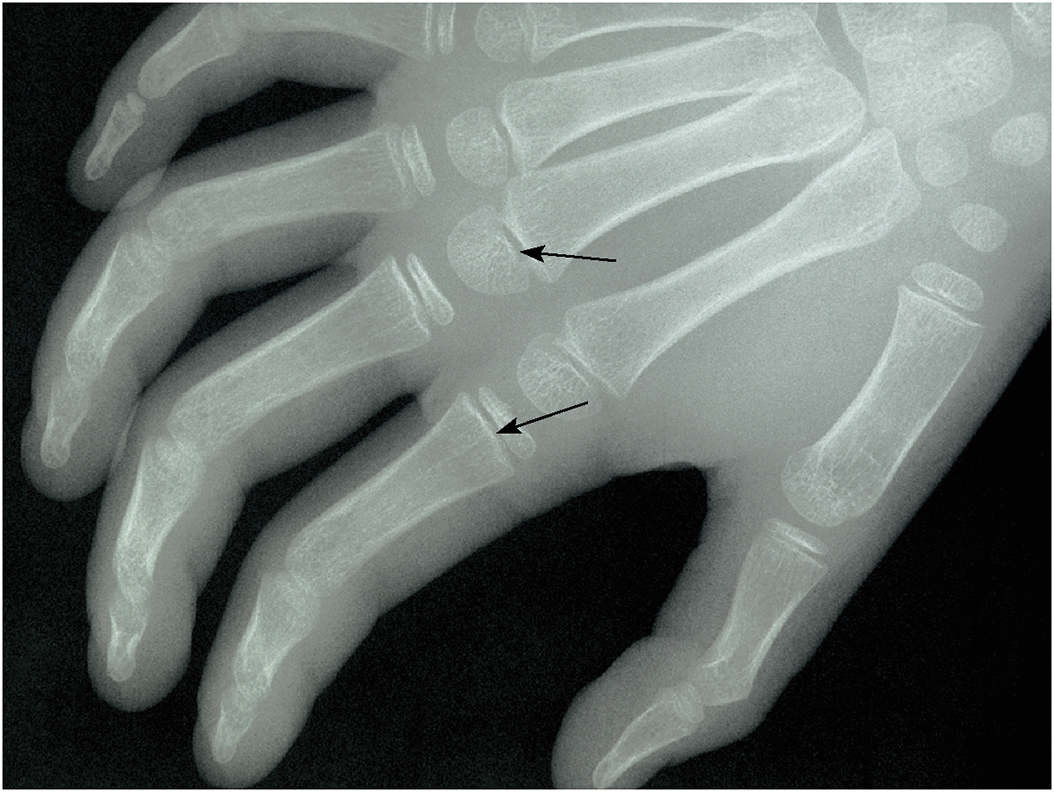
why is the epiphyseal plate important?
lengthens the bone, GROWTH!
55
New cards
what factors remodel bone
bones remodeled, or reshaped, throughout life, when a
1. person’s activity level changes
2. bone is recovering from fracture
3. level of blood calcium changes
1. person’s activity level changes
2. bone is recovering from fracture
3. level of blood calcium changes
56
New cards
explain how osteoclasts & osteoblasts remodel bone
1. osteoblasts deposit matrix
2. osteoclasts resorb, or remove matrix
57
New cards
what % of the skeleton is replaced every year due to bone tissue remodeling?
3-5%
58
New cards
both compact & spongy bone contain 3 types of cells:
osteocytes: ECM surrounds osteoblasts
osteoblasts: bone-forming cell
osteoclasts: break down matrix
osteoblasts: bone-forming cell
osteoclasts: break down matrix
59
New cards
what factors affect bone development, growth, & repair
1. nutrition
2. exercise
3. hormones
60
New cards
Vitamin A
activates osteoblasts
61
New cards
Vitamin C
promotes collagen production
62
New cards
Vitamin D
stimulates absorption & transport of calcium phosphate ions
63
New cards
why is Vitamin D important?
without this, bones lack normal mineral content & are soft & deformed
64
New cards
exercise
* builds muscles
* stress increases thickness & strength of bone
* stress increases thickness & strength of bone
65
New cards
growth hormone
causes division of cartilage cells in epiphyseal plates
66
New cards
sex hormones
* stimulate osteoblasts
* promote epiphyseal plate growth & eventual closure
* promote epiphyseal plate growth & eventual closure
67
New cards
calcitonin
released when there is a high blood calcium level; stimulates osteoblasts to build bone and store excess calcium; inhibits osteoclasts
68
New cards
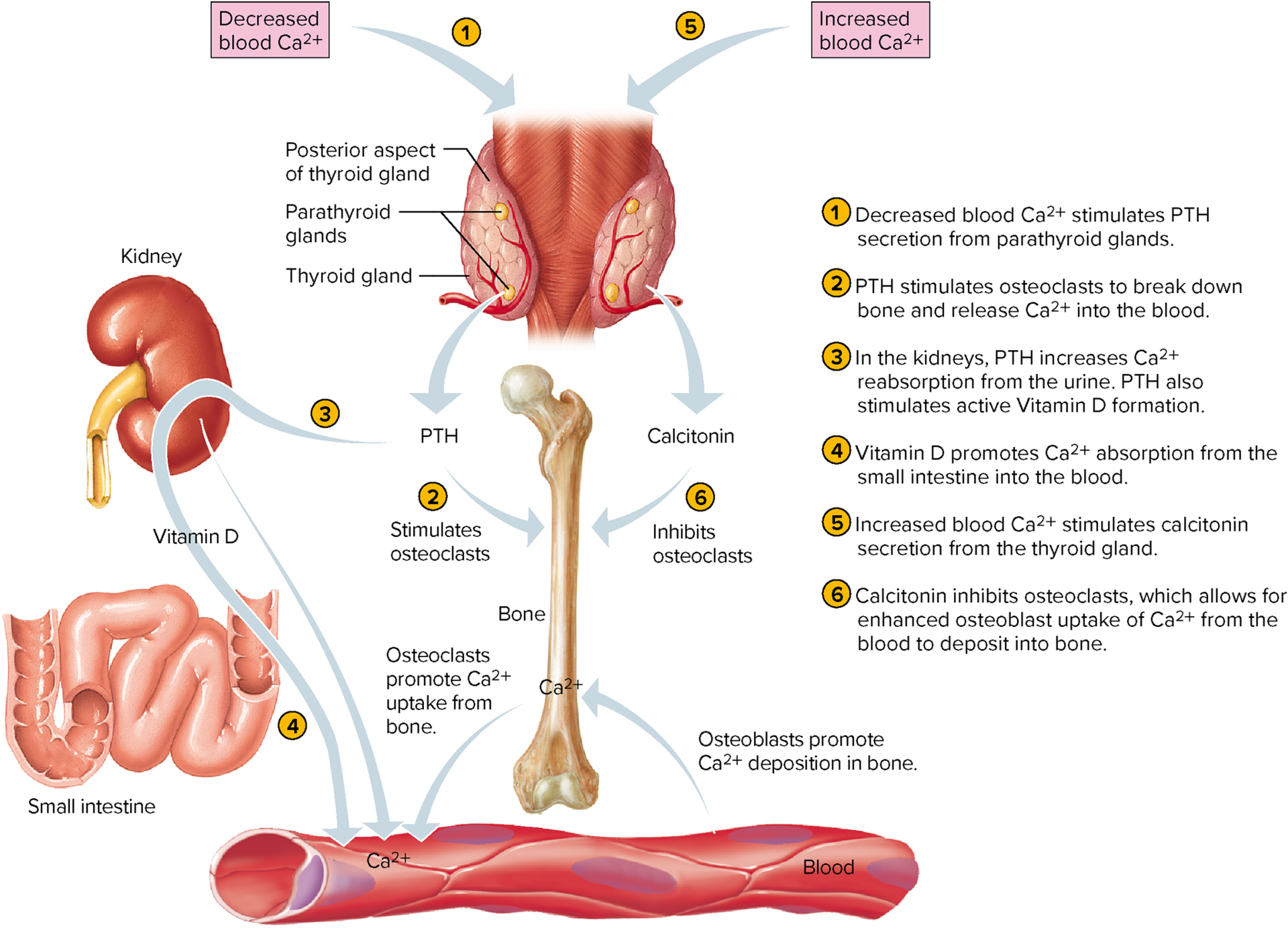
parathyroid hormone (PTH)
released when there is a low blood calcium level; stimulates osteoclasts to resorb bone and release stored calcium into blood
69
New cards
fracture
break in a bone
70
New cards

greenstick fracture
* incomplete
* break occurs on convex surface of bend in bone
* break occurs on convex surface of bend in bone
71
New cards

fissured fracture
incomplete longitudinal break
72
New cards

comminuted fracture
complete & bone fragments
73
New cards
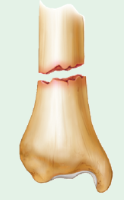
transverse fracture
* complete
* break occurs at right angle to the axis of the bone
* break occurs at right angle to the axis of the bone
74
New cards
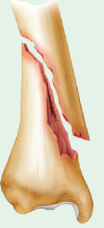
oblique fracture
at an angle other than a right angle to the axis of the bone
75
New cards
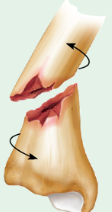
spiral fracture
caused by excessive twisting of bone
76
New cards

step 1 of bone repair
blood escapes from ruptured blood vessels & forms hematoma
\+ periosteum likely to tear
\+ surrounding tissue vessels dilate, swell, & inflame the tissue
\+ periosteum likely to tear
\+ surrounding tissue vessels dilate, swell, & inflame the tissue
77
New cards
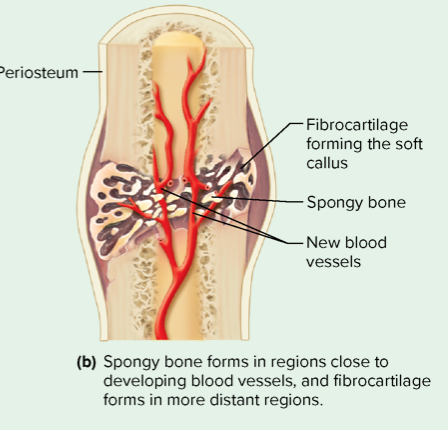
step 2 of bone repair
spongy bone forms (osteoblasts job) in regions close to developing blood vessels & fibrocartilage forms (fibroblasts job) in more distant regions
\+ phagocytic cells remove blood clot & dead or damaged cells in affected area
\+ osteoclasts resorb bone fragments - “clean up”
\+ phagocytic cells remove blood clot & dead or damaged cells in affected area
\+ osteoclasts resorb bone fragments - “clean up”
78
New cards
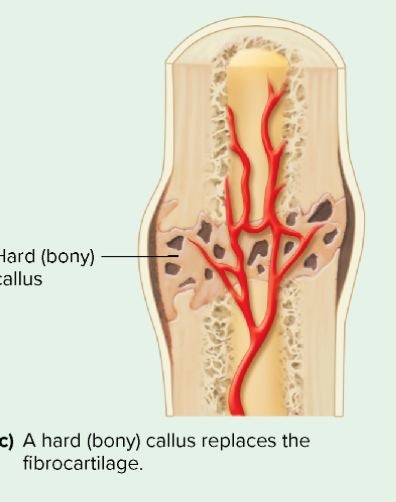
step 3 of bone repair
a hard bony callus replaces fibrocartilage (cartilaginous soft callus)
\+ blood vessels & osteoblasts invade area
\+ blood vessels & osteoblasts invade area
79
New cards
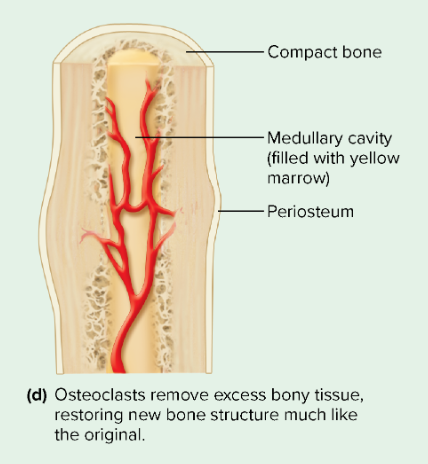
step 4 of bone repair
osteoclasts remove excess bony tissue, restoring new bone structure much like the original
80
New cards
joint (articulations)
union of 2 or more bones
81
New cards
joint functions
1. make possible bone growth
2. permit parts of skeleton to change shape during childbirth
3. enable body to move in response to skeletal muscle contractions
82
New cards
diarthrotic
free movement
83
New cards
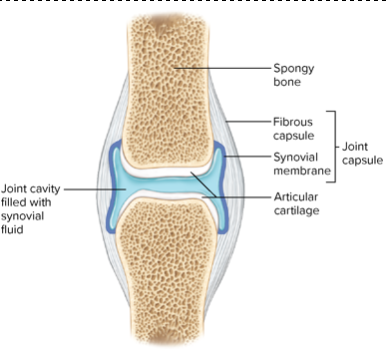
synovial joints
* surrounded by joint capsule of ligaments & synovial membranes; ends of bones covered by articular cartilage & separated by synovial fluid
* diarthrotic
* diarthrotic
84
New cards
why is synovial fluid important?
lubricates joints, prevents friction
85
New cards
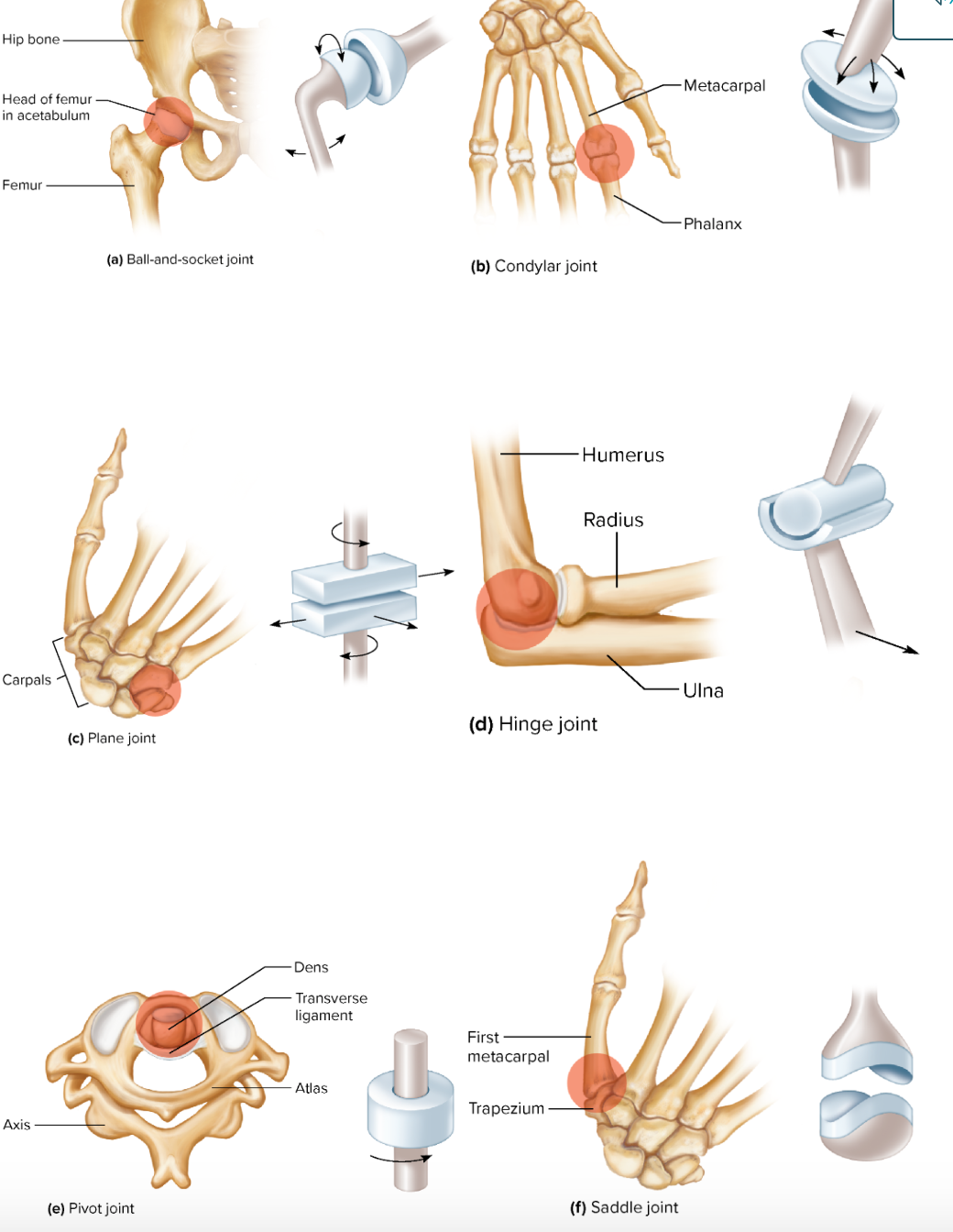
types of synovial joints
1. **ball-and-socket joint (focus for this class)**
2. condylar joint
3. plane joints
4. **hinge joint (focus for this class)**
5. pivot joint
6. saddle joint
86
New cards
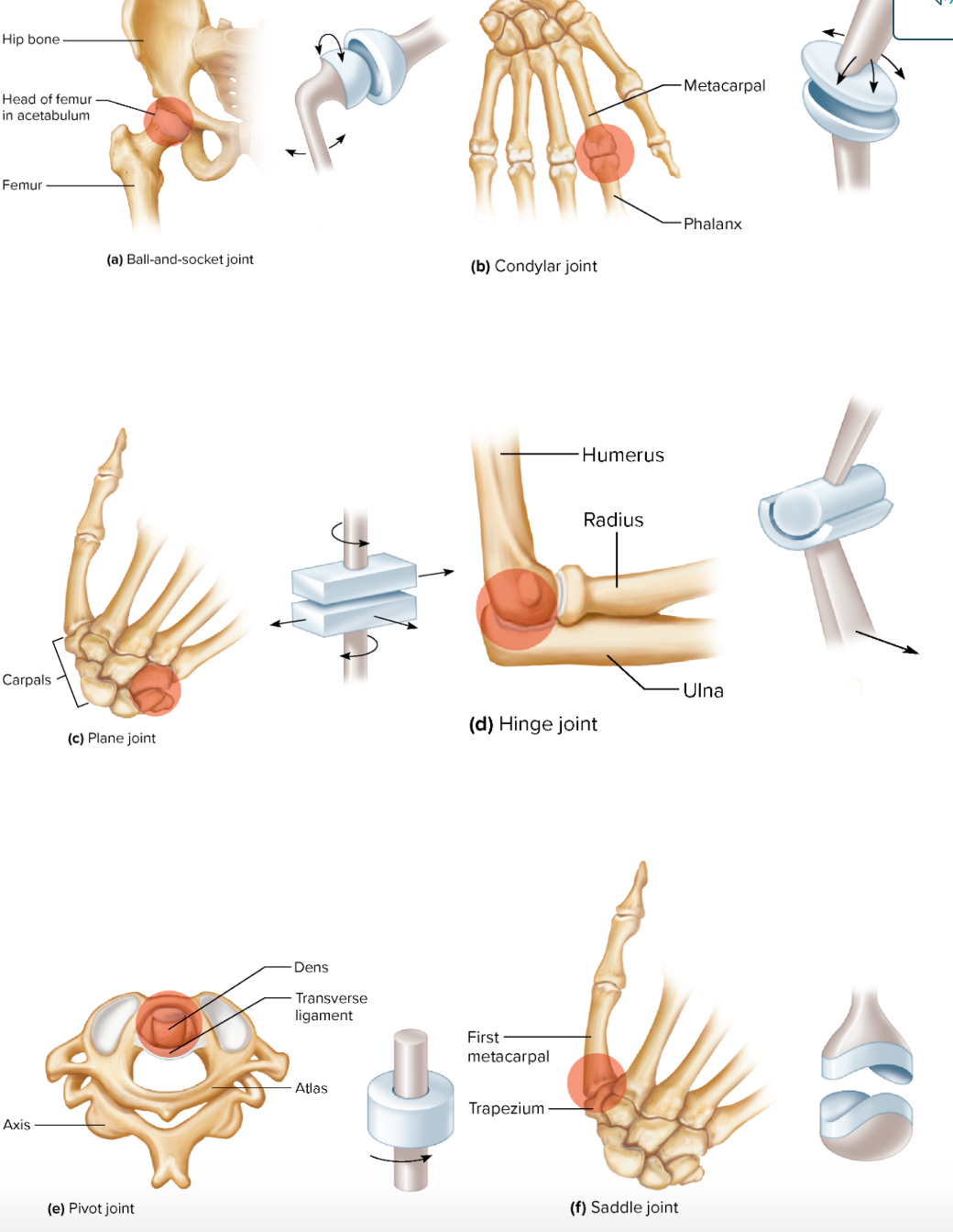
ball-and-socket joint
* ball-shaped head of one bone articulates w cup-shaped cavity of another
* movements in all planes, including rotation
* shoulder, hip
* movements in all planes, including rotation
* shoulder, hip
87
New cards

hinge joint
* convex surface of one bone articulates w concave surface of another
* flexion & extension
* elbow, joints of phalanges
* flexion & extension
* elbow, joints of phalanges
88
New cards
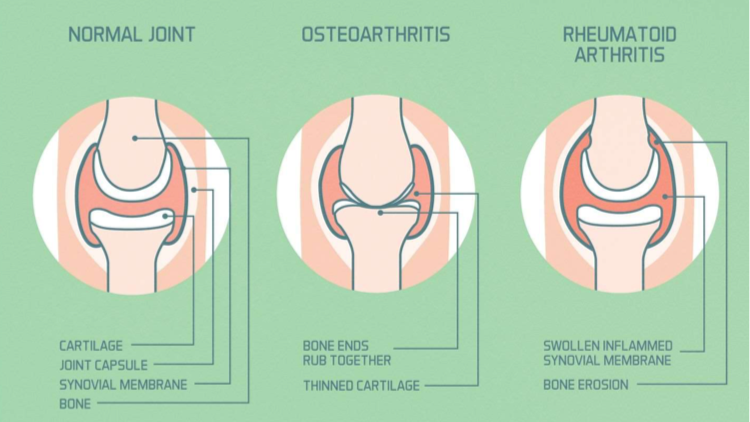
rheumatoid arthrisis (RA)
* autoimmune disorder where the immune system attack the body’s healthy tissues - painful & debilitating
* synovial membrane inflamed/thickened, articular cartilage damaged, fibrous tissue infiltrates
* synovial membrane inflamed/thickened, articular cartilage damaged, fibrous tissue infiltrates
89
New cards
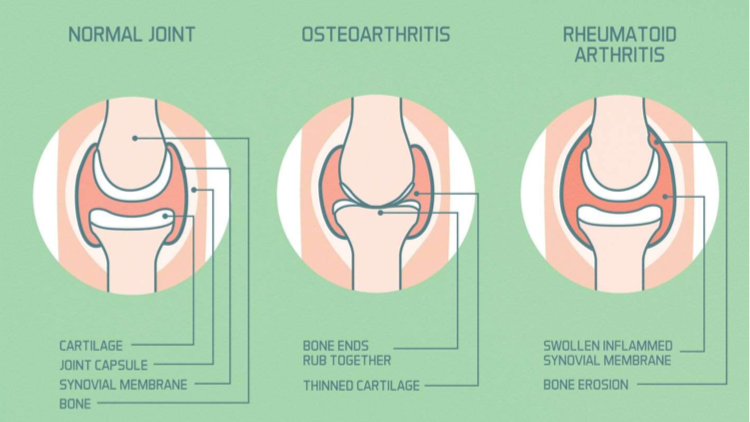
osteoarthritis (OA)
* degenerative disorder that results from aging or poorly healed injury
* articular cartilage softens & disintegrates
* articular cartilage softens & disintegrates
90
New cards
bone mineral density test
* X-ray measures how much calcium & minerals are in bone segment
* when? older age = people heightened risk for osteoporosis
* why? osteoporosis diagnosis & helps understand risk of breaking a bone in the future
* when? older age = people heightened risk for osteoporosis
* why? osteoporosis diagnosis & helps understand risk of breaking a bone in the future
91
New cards
osteoporosis
bone diseases that causes bones to lose strength, making them susceptible to fractures
92
New cards
physiology behind osteoporosis
normally, osteoblasts deposit new bone and osteoclasts resorb bone to maintain its shape in remodeling process, which works to keep bone young;
HOWEVER, w osteoporosis, osteoclasts resorb bone at a faster rate than osteoblasts can deposit new bone; thus, bone is lost.
HOWEVER, w osteoporosis, osteoclasts resorb bone at a faster rate than osteoblasts can deposit new bone; thus, bone is lost.
93
New cards
uncontrollable risk-factors
age, sex, body frame/size, family history, genetics, race
94
New cards
controllable risk factors
level of exercise, diet insufficient in calcium & Vitamin D, smoking tobacco, excessive drinking of alcohol
95
New cards
symptoms
1. height loss
2. stooped posture
3. back pain due to weakened vertebrae
4. easily fractured bones
96
New cards
why does osteoporosis happen?
with natural aging, a person’s bones have weakened regenerative abilities
97
New cards
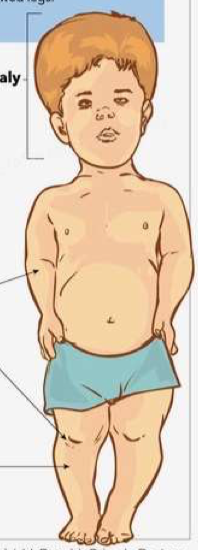
achondroplasia
* slower conversion of epiphyseal plate cartilage to bone (less interstitial growth)
* short, stocky limbs result, but trunk normal size
* genetic
* short, stocky limbs result, but trunk normal size
* genetic
98
New cards
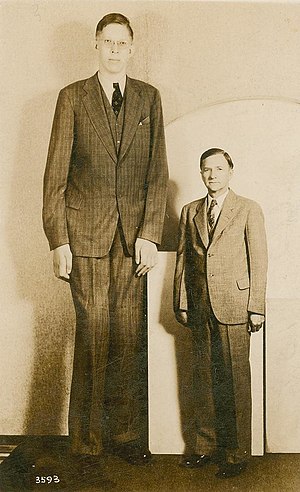
gigantism
* overproduction of growth hormone before puberty (increased interstitial growth)
* puberty often delayed = more time for **interstitial growth**
* seen in childhood
* puberty often delayed = more time for **interstitial growth**
* seen in childhood
99
New cards
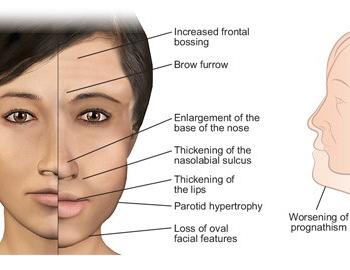
acromegaly
* overproduction of growth hormone after epiphyseal cartilages close → **appositional growth**
* bones get thicker, not longer, esp face, jaw, & hands
* seen in adulthood
* bones get thicker, not longer, esp face, jaw, & hands
* seen in adulthood
100
New cards
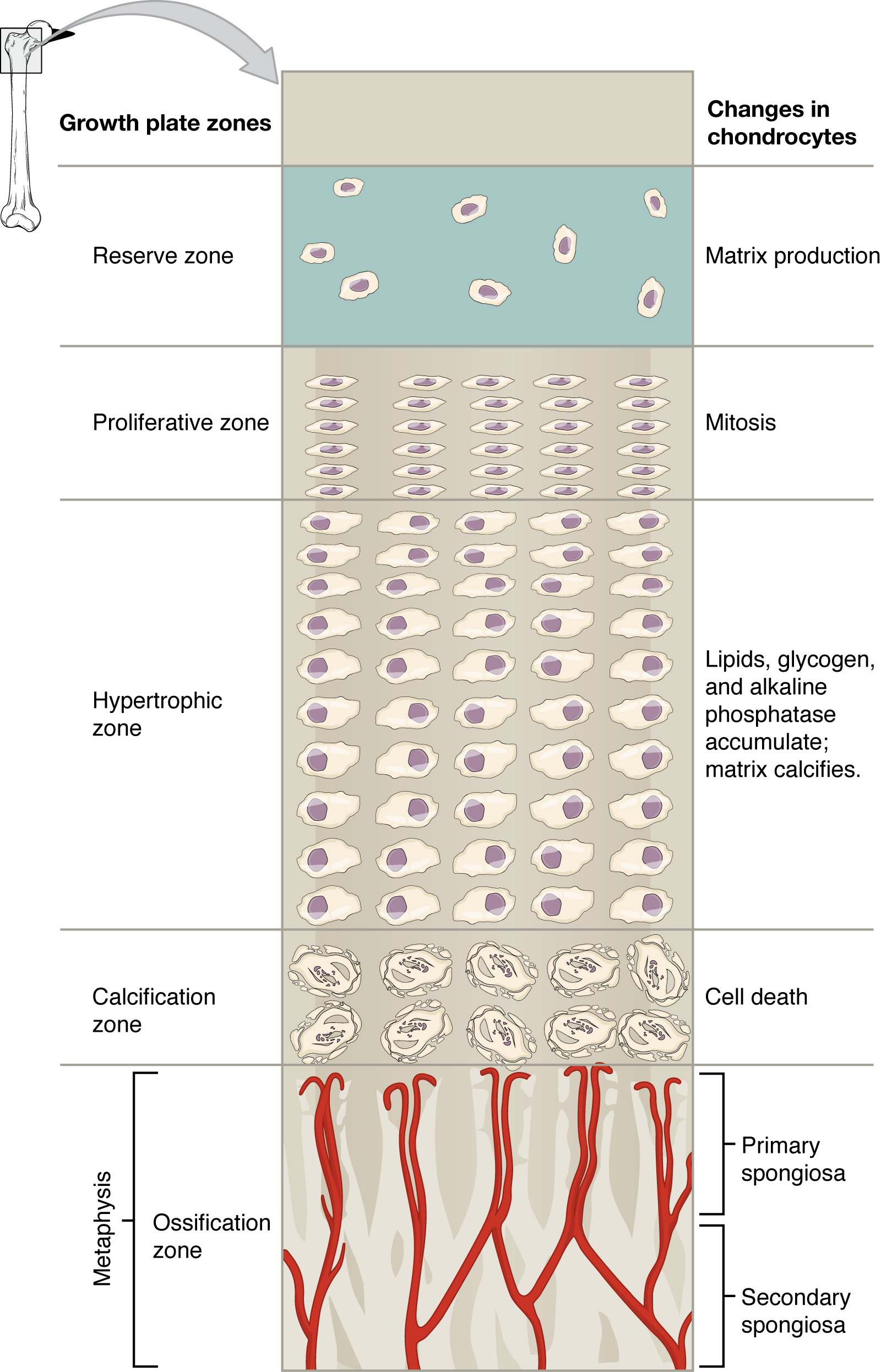
1. zone of resting cartilage
normal hyaline cartilage; chondrocytes in lacuna surrounded by ECM